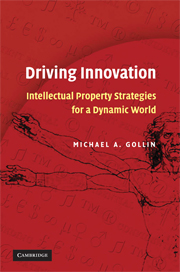Book contents
- Frontmatter
- Contents
- Foreword
- Preface
- Acknowledgments
- Abbreviations
- Introduction: The Invisible Infrastructure of Innovation
- PART I INTELLECTUAL PROPERTY DYNAMICS IN SOCIETY
- PART II BASICS OF MANAGING INTELLECTUAL PROPERTY IN ORGANIZATIONS
- PART III STEPS TO STRATEGIC MANAGEMENT OF INTELLECTUAL PROPERTY
- 8 Becoming Strategic
- 9 Strategy Tools: Policies and Practices for Managing Intellectual Property
- 10 A Menu of Strategy Options
- 11 Evaluating Internal Resources and the External Environment
- 12 Placing a Financial Value on Intellectual Property Assets
- 13 Accessing Innovations of Others
- 14 Acquiring and Policing Intellectual Property Rights
- 15 Doing Innovation Deals
- PART IV STRATEGIES ON A GLOBAL STAGE
- APPENDIX A Excerpts from TRIPS Agreement
- APPENDIX B Intellectual Property Non-Policy
- APPENDIX C Intellectual Property Assessment Questionnaire
- APPENDIX D Research Tools for Obtaining Intellectual Property Information
- Bibliography
- Index
15 - Doing Innovation Deals
Published online by Cambridge University Press: 05 June 2012
- Frontmatter
- Contents
- Foreword
- Preface
- Acknowledgments
- Abbreviations
- Introduction: The Invisible Infrastructure of Innovation
- PART I INTELLECTUAL PROPERTY DYNAMICS IN SOCIETY
- PART II BASICS OF MANAGING INTELLECTUAL PROPERTY IN ORGANIZATIONS
- PART III STEPS TO STRATEGIC MANAGEMENT OF INTELLECTUAL PROPERTY
- 8 Becoming Strategic
- 9 Strategy Tools: Policies and Practices for Managing Intellectual Property
- 10 A Menu of Strategy Options
- 11 Evaluating Internal Resources and the External Environment
- 12 Placing a Financial Value on Intellectual Property Assets
- 13 Accessing Innovations of Others
- 14 Acquiring and Policing Intellectual Property Rights
- 15 Doing Innovation Deals
- PART IV STRATEGIES ON A GLOBAL STAGE
- APPENDIX A Excerpts from TRIPS Agreement
- APPENDIX B Intellectual Property Non-Policy
- APPENDIX C Intellectual Property Assessment Questionnaire
- APPENDIX D Research Tools for Obtaining Intellectual Property Information
- Bibliography
- Index
Summary
This chapter relates to transferring IP rights to implement a management strategy. It begins with the basic elements of making deals relating to intellectual property. It continues with the principles of owning innovations, including how to acquire ownership of IP assets, and what ownership means. The next section describes transferring rights in intellectual property to implement a strategic plan. Assignments, licenses, and other types of transfer are described. Details for transferring each type of IP assets are given – trade secrets, patents, copyright, and trademarks. There are reasons for an owner to license out, but also some disadvantages. The final section outlines the pivotal terms and conditions in IP transfer agreements, both noneconomic (granting clause, exclusivity, field of use, and so on), and economic terms. This chapter concludes with some general advice on how to approach IP deal-making.
In 1995, I traveled to Verata village in Fiji, put on a local sulu sarong skirt, and sat cross-legged on straw mats in an open thatched meeting shelter with community leaders and other outsiders. Our host, Bill Aalbersberg, speaking Fijian, recited the terms of a biodiversity access- and benefit-sharing agreement that had been negotiated during the preceding week. The villagers planned to collect plants and marine invertebrates in collaboration with biologists from the University of the South Pacific, then to provide them to Smith-Kline Beecham for pharmaceutical research, in exchange for payments, training, and a royalty on sales of any resulting products.
- Type
- Chapter
- Information
- Driving InnovationIntellectual Property Strategies for a Dynamic World, pp. 263 - 286Publisher: Cambridge University PressPrint publication year: 2008

